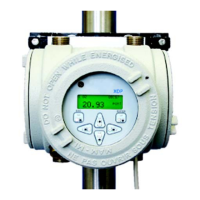
Do you have a question about the GE XDP-H2 and is the answer not in the manual?
| Accuracy | ±0.1% Full Scale |
|---|---|
| Display | LCD |
| Power | Battery |
| Operating Temperature | 0 to 50°C |
| Power Supply | 9V battery |
Outlines the procedure for returning instruments for repair or replacement under warranty.
Provides an overview of the XDP system and its function in gas monitoring.
Details the key hardware and software features of the XDP unit.
Explains the XDP's integration with transmitters and a typical use case.
Details a specific use case for the XDP in generator cooling systems.
Describes how alarms are configured for a typical application, including normal and fault states.
Introduces the installation process and highlights critical safety precautions.
Provides criteria for choosing the optimal location for the XDP installation.
Step-by-step instructions for physically mounting the XDP enclosure and transmitter.
Comprehensive guide to connecting power, input/output signals, and communication interfaces.
Overview of the operation chapter and its topics, including basic use and troubleshooting.
Essential precautions and tips to avoid common issues during XDP operation.
Instructions on how to clean the XDP unit's exterior and display window.
Steps for safely powering on the XDP and allowing sufficient warm-up time.
Guide to entering and using the XDP's user-level programming interface.
Procedures for safely exiting programming modes and returning to normal operation.
Explains common error messages, their causes, and suggested remedies for diagnosis.
Overviews the importance of proper setup and calibration for accurate readings.
Steps to choose the specific gas mixture (e.g., H2/AIR) the XDP will monitor.
How to cycle through different display configurations to view various data.
Procedure for fine-tuning the contrast of the XDP's liquid crystal display.
Options for configuring the display backlight behavior (On, Off, Timed).
How to set up and configure the system fault alarm relay for specific conditions.
Configuration of analog output types, setpoints, and testing for external devices.
Configuration of serial communication parameters like Node ID, baud rate, and parity.
Details on locking menus and viewing versions.
Detailed instructions for performing zero and span calibration to ensure measurement accuracy.
Overview of advanced features available for fine-tuning system performance.
Explains the different access levels (Operator, Setup, Factory) and their required passwords.
Detailed steps for configuring display parameters, outputs, alarms, and serial ports.
Instructions for entering serial numbers, calibration data, and loading software.
Lists key performance metrics like accuracy, linearity, response time, and stability.
Details enclosure type, power input, fuse, and output specifications.
Outlines alarm capabilities, analog I/O, communication, display, and measurement ranges.
Information on operating conditions, compliance with directives, and certifications.
Directs users to separate documentation for transmitter-specific details.
States the requirement for CE mark compliance in EEC countries.
Details wiring modifications needed to meet Electromagnetic Compatibility standards.
Outlines requirements for an external power disconnect device for LVD compliance.
Introduces additional built-in features like system analog output and fault alarm.
Provides wiring details for the system analog output (J5) and system fault alarm relay (J2).
Details on wiring four supplemental alarm relays located at terminal block J7.
Visual representation of the menu flow for calibration and display settings.
Visual representation of the menu flow for optional settings and user functions.
Visual representation of the menu flow for configuration and setup options.
Visual representation of the menu flow for advanced factory-level configurations.
